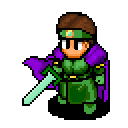 |
This measures someone's "Hit Points," or the amount of
damage they can take. When someone's HP becomes 0, they die.
|
 |
This is "Magic Points," which is a measure of one's magical
endurance; whenever someone casts a spell, a certain amount of
their MP is consumed. When someone's MP is too low to cast a
certain spell, they can't cast the spell--they have to wait
until they have enough MP. MP increases as WT counts down.
|

| This is "Strength." It is a direct measure of how
strong someone's physical attack is; a character's raw attack
power (attack power with no weapons) is determined by taking
their STR and adding half of their DEX. |
 |
This is "Vitality." This is another measure of a character's
endurance--the higher someone's VIT is, the better physical
defense they will have. Better physical defense means that
they will lose less HP when attacked. |
 |
This is "Intelligence," a direct measurement of someone's
capacity to cast spells. A character's raw magic attack
power (magic attack power with no staffs, rings, necklaces,
etc.) is determined by taking their INT and adding half of
their MEN. |
 |
This is "Mentality," which is directly related to one's
defense against spells. Having high mentality means that
someone takes less damage from spells that are casted on them.
A character's raw magic attack power (magic attack power with
no staffs, rings, necklaces, etc.) is determined by taking
their INT and adding half of their MEN. Also, the strength of
many special attacks depend on the MEN of the character that
uses them. |
 |
This is "Agility," which is a measure of a character's speed.
Those with high AGI are more accurate in their attacks and
better at evading attacks directed at them. Furthermore, a
character's base WT (waiting time without any equipment on)
is determined by subtracting their AGI from 550. |
 |
This is "Dexterity," a measure of one's "skill." A
character's DEX is directly proportional to their accuracy.
For supplemental magic users such as Warlocks, Witches, and
Sword Masters, high DEX (along with low WT) is a priceless
asset. DEX is also directly proportional to a character's
raw attack power (attack power with no weapons), which is
determined by taking their STR and adding half of their DEX.
|
 |
This is the character's "Luck." In battle, a character's LUK
is directly proportional to the rate at which they get
critical hits. Also, the possible items that a character can
find as buried treasure at a given spot depends on their LUK.
Furthermore, a character's LUK is related to the probability
that they will get treasure from killing an enemy--those with
high LUK tend to get treasure more often, while those with low
LUK tend to get stat-boosting cards. |
 | This is a
character's "Alignment," which says something about the
character themself, as opposed to their ability in battle.
There are three different Alignments:
L: Law. People with this
alignment play by the rules and obey the law, often times
being restricted by it.
C: Chaos. People with this alignment value
their freedom over any laws. They tend to be the rebels, who
act on their own.
N:
Neutral. People with this alignment recognize the
need to obey the law, but who balance obedience and freedom.
The middle path.
The possible classes that a
character can change to depend on their Alignment. |
 |
This is the number of "Kills" that the character has. In
most cases this statistic does not matter, but in some cases,
it does. The classes of Terror Knight, Black Dragon, and
Tiamat have a minimum kill requirement, while the classes of
Cleric and Priest have a maximum kill requirement. |



